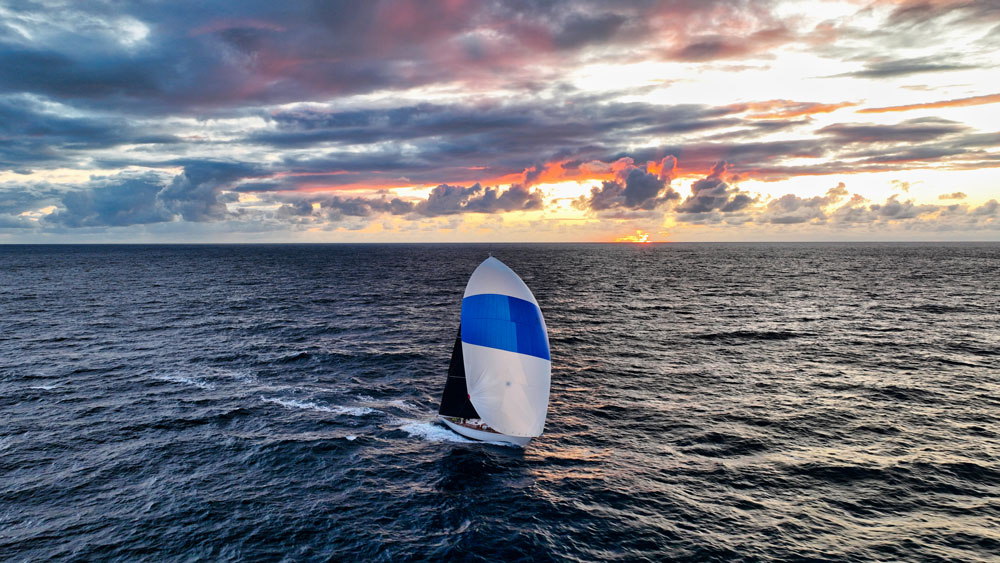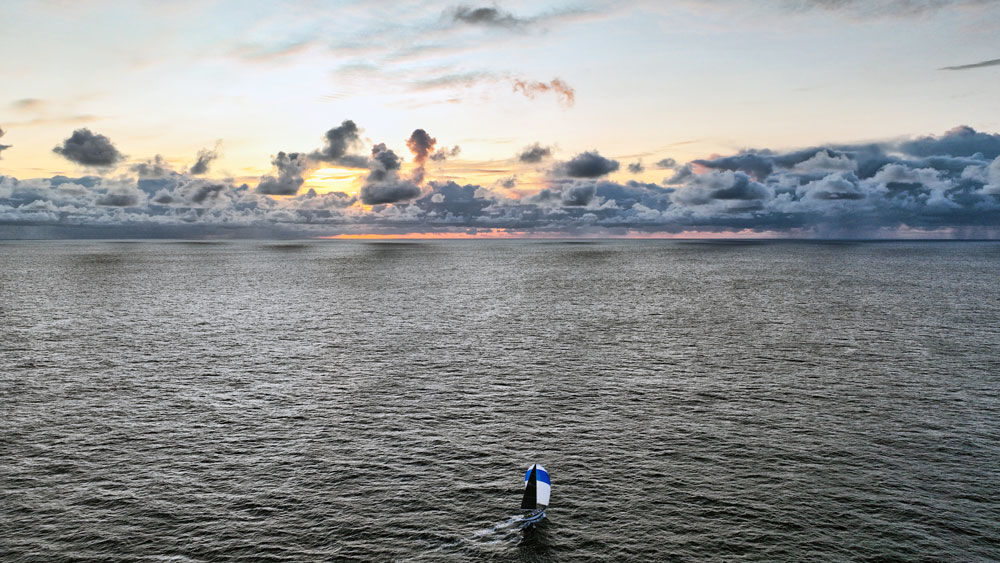When Seahorse Magazine learned that I’d be in Cowes for the finish of the 2025 Transatlantic Race, they asked for an answer to the perennial question: Why race across an ocean? Unfortunately they were unable to find room for the piece in a timely manner, so I’m publishing it here instead. Enjoy!
With such a busy summer on both sides of the Pond, the Transatlantic Race that started in Newport on 18 June was perhaps easy to miss. For those of us following along from ashore, it was possible to virtually hop aboard many of the boats—in almost real time. We learned about fixing broken head seats and the (non) joys of spam from Sara Burke on High Note . . . and then watched in horror as the entire crew abandoned ship*. After that, drone footage showing how tiny a yacht looks when sailing across open ocean seemed even more poignant.

1. Teamwork
One of the many crew members trying to answer the question “Why go ocean racing?” was Michel Linzer. The 30-year-old onboard reporter sailed on Haspa Hamburg, a 52 footer purpose-built by the Hamburgischer Verein Seefahrt to give young sailors offshore experience. It was Michel’s first transatlantic, and he plans to create a short movie about the voyage.
“I thought I would be able to answer that question in 14 days,” he says, [but] “nobody can tell you why we are doing this. It’s wet, it’s cold, it’s foggy… and it’s all this work. You’re in the middle of the night with a kite that is too big for the wind…” He waves at that poor sail, now lying on the dock awaiting repair. “Why would a normal person bring himself into all this kind of tension? I still haven’t found the answer.”
Another Haspa sailor is more definitive. “For me, the biggest thing is the team experience,” Josephin Brand says. On watch, talking about single-handed races, “Someone said, like, why would you do that? To have no one to talk with or to share the experience.”
Asked for her specialty onboard, Josephin (an architecture student) says she shares the pit duties with Lina Bienmüller (an architect). Also, “You can really rely on me in any situation. I will do the meal for everyone when it blows 40 knots, I don’t mind.” Laughing, she adds, “I’m one of the snack-ticians on the boat. I love to get everyone their snacks.”
Lina adds another reason she likes going offshore. “You know something is going to happen where you will have to find a solution. I think that’s a bit cheating in inshore sailing; you can just go home and fix all of that.”
2. Family
Moana, a German-flagged Marten 49, had father and son Hanno and Robert Ziehm onboard as owner and bowman. “We have this boat for about 10 years,” Hanno says, “and we started planning for this event about four years ago. It was extremely exciting, and we are very happy that we are here safe.”
Robert calls sharing the experience with his dad a dream come true. “It was everything offshore sailing should be: tough, tactical, emotional—and absolutely exhilarating.” They have now completed the full Atlantic loop and will return to Kiel after the Fastnet Race.
For his fifth Transatlantic Race in a row, in search of a more comfortable ride, Clarke Murphy chartered the 82-footer Ikigai. Two of his four kids joined him, along with several pros who are almost family as well. “We sail all over the world together,” Clarke explains. “They are really, really, really good sailors—and all drop-dead funny. When things go bang at three in the morning, which they always do, you do what you need to do and then you tease whoever was on watch that it’s their fault. And that’s what it’s all about.”
For his daughter Morgan, the answer since she was six years old to “what do you want to do when you grow up” was “cross the Atlantic. I’ve seen my dad do it, and the first email I remember ever sending was to the boat. So it was just incredible to do this race.”
Her favorite moment was on a day without much wind. “I was with my brother, my dad, and I looked around… [it] was surreal. When you don’t see anything, to me, that’s so calming. So I’m in the middle of the Atlantic, and we’re just holding our stomachs we’re laughing so hard! And I am actually doing what I’ve been thinking about for so long… just like, wow.”
Brother Liam is three years younger than Morgan; this was his third transatlantic. “I was 17 when I did my first one, the last [west to east] race,” he says. Last December, after finishing university, he sailed east-west with the Atlantic Rally for Cruisers. In school, if a professor didn’t agree to his taking time off to go sailing, he would switch classes. “Because of Dad and all the offshore racing that he did, I always wanted to be a part of it.”
Unlike his sister, Liam didn’t particularly enjoy the calm spells. “My least favorite parts are when the speed is 0.0 knots. I love to race. I love to go fast. So I just get itchy and ready to move.” He really enjoyed the ocean’s natural beauty; “Seeing dolphins at night outlined in the phosphorescence. And then just lying down and looking up at the stars; it’s about as clear as it gets.”
“When you’re racing,” their father says, “as anyone who reads Seahorse would know, it’s all consuming; all focused. Your entire world is wrapped in fiberglass or aluminum or carbon fiber. And if you really enjoy the people in that world in which you live, there’s nothing more challenging or more joyous.”
3. Cutting away noise
For Hound watch captain Dave Rosow, the race brought everything else into perspective. Calling it “type two fun” (type one is when everything is actually enjoyable in the moment), he says, “I’m really happy to have done this race. It cut away the noise; distills it right down to what is most important. For me, that’s my family. So when I could get a text or a picture or a sweet line of support it was very touching.”
Of course there’s also his Hound family, which has gelled over several Caribbean 600s and Bermuda races. “If I had passed on the opportunity and then heard the stories, I would have kicked myself. To be able to do a crossing with this group of people is a treasure.”
4. Competitive Adventure
After two weeks of racing, three of the four boats in IRC One crossed the line off the Royal Yacht Squadron within minutes of each other. Moana eked out a class win over Haspa Hamburg, with Ikigai and Hound rounding out the results. Clarke Murphy calls the close finish “crazy, after 3,000 miles.” Once they all tied up at the dock, the other crews “ran down to us, and there’s 30 of us high-fiving each other. That’s the whole thing, right there.”
A day after that photo finish, even Michel on Haspa Hamburg has answers to his pre-race question (why race offshore). First, the adventure; “Taking the waves and the wind to get from one continent to the other. This feeling of sailing around an eighth of the total earth’s circumference…”
Second, the competition. “Meeting our competitors again is so strange—and so great as well.” Their fellow Germans on Moana are like family, and “Of course, we wanted to get here two days in front of them! But to have this tension in the last hours of this race was great, because everybody was on the edge of their seat.”
The onboard reporter also took time to appreciate the wildlife. “There are dolphins, there are whales, there are some birds in the middle of the Atlantic—I don’t know why but they are there. You can touch it, you can feel it, it’s not that abstract anymore. And so the world is getting small for me; it makes the other seven-eighths [of the globe] seem doable.”

Wildlife, family time, adventure and competition, the chance to meet challenges supported by a team; all great reasons to sign on for the next Transatlantic Race. And thanks to ever-improving technology, future races will be even easier to experience from the dry safety of our armchairs—if only to wonder at how tiny a large yacht appears when sailing across open ocean.
*For more details about the High Note rescue, read Sara Burke’s updates on My Transatlantic Race.